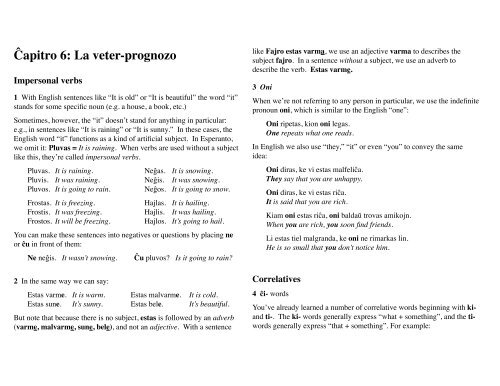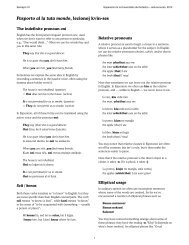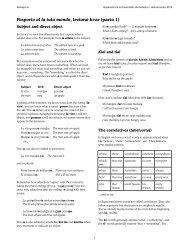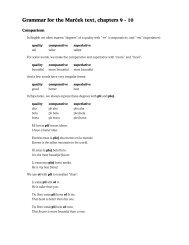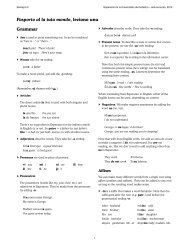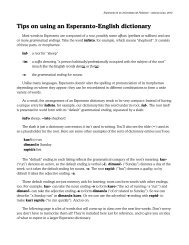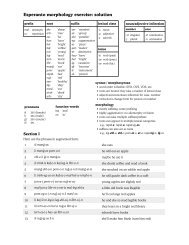The alphabet and pronunciation - Lodestone
The alphabet and pronunciation - Lodestone
The alphabet and pronunciation - Lodestone
- No tags were found...
You also want an ePaper? Increase the reach of your titles
YUMPU automatically turns print PDFs into web optimized ePapers that Google loves.
!apitro 6: La veter-prognozoImpersonal verbs1 With English sentences like “It is old” or “It is beautiful” the word “it”st<strong>and</strong>s for some specific noun (e.g. a house, a book, etc.)Sometimes, however, the “it” doesn’t st<strong>and</strong> for anything in particular:e.g., in sentences like “It is raining” or “It is sunny.” In these cases, theEnglish word “it” functions as a kind of artificial subject. In Esperanto,we omit it: Pluvas = It is raining. When verbs are used without a subjectlike this, they’re called impersonal verbs.! Pluvas.! It is raining.! Ne"as.! It is snowing.! Pluvis.! It was raining.! Ne"is.! It was snowing.! Pluvos.! It is going to rain.! Ne"os.! It is going to snow.! Frostas.! It is freezing.! Hajlas.! It is hailing.! Frostis.! It was freezing.! Hajlis.! It was hailing.! Frostos.! It will be freezing.! Hajlos.! It’s going to hail.You can make these sentences into negatives or questions by placing neor "u in front of them:! Ne ne"is.! It wasn’t snowing.! !u pluvos?! Is it going to rain?2 In the same way we can say:! Estas varme.! It is warm.! Estas malvarme.! It is cold.! Estas sune.! It’s sunny.! Estas bele.! It’s beautiful.But note that because there is no subject, estas is followed by an adverb(varme, malvarme, sune, bele), <strong>and</strong> not an adjective. With a sentencelike Fajro estas varma, we use an adjective varma to describes thesubject fajro. In a sentence without a subject, we use an adverb todescribe the verb. Estas varme.3 OniWhen we’re not referring to any person in particular, we use the indefinitepronoun oni, which is similar to the English “one”:! Oni ripetas, kion oni legas.! One repeats what one reads.In English we also use “they,” “it” or even “you” to convey the sameidea:! Oni diras, ke vi estas malfeli#a.! <strong>The</strong>y say that you are unhappy.! Oni diras, ke vi estas ri#a.! It is said that you are rich.! Kiam oni estas ri#a, oni balda$ trovas amikojn.! When you are rich, you soon find friends.! Li estas tiel malgr<strong>and</strong>a, ke oni ne rimarkas lin.! He is so small that you don’t notice him.Correlatives4 "i- wordsYou’ve already learned a number of correlative words beginning with ki<strong>and</strong>ti-. <strong>The</strong> ki- words generally express “what + something”, <strong>and</strong> the tiwordsgenerally express “that + something”. For example:


